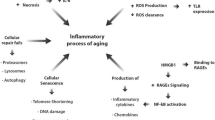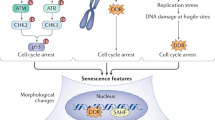Abstract
The possible effects of specificspontaneous changes in protein chemistry onage-related homeostatic dysfunction arediscussed. Spontaneous racemization andisomerization of aspartic acid and deamidationof asparagine to four possible forms ofaspartic acid in caspases and their substratescould profoundly alter apoptotic activity.Deamidation of asparagine residues atcritically important sites of DNA glycosylasescould compromise base excision repairactivity. Furthermore, as oxidative damage mayenhance asparagine/aspartate instability inproteins, and erroneously-synthesized proteins show increased susceptibility tooxidative attack, it is beginning to appearthat the aberrant protein forms thataccumulate during ageing are possiblyinterrelated. The role of cell growth rates incontrolling constitutive proteolyticelimination of various forms of aberrantpolypeptides is then discussed. Finally, it ispointed out that three recently describedagents that delay senescence in cultured cells(aminoguanidine, N-t-butylhydroxylamine andkinetin) resemble carnosine in that they arealso likely to react with glycoxidisedproteins, as well as possess anti-oxidant activity. These observations suggest thatpluripotency may be a necessary pre-requisitefor effective anti-ageing activity.
Similar content being viewed by others
References
Atamna H, Cheung I and Ames BN (2000a) A method for detecting abasic sites in living cells: age dependent changes in base excision repair. Proc Natl Acad Sci USA 97: 686–691
Atamna H, PalerMartinez A and Ames BN (2000b) N-tbutylhydroxylamine, a hydrolysis product of ?-phenyl-N-tbutylnitrone, is more potent in delaying senescence in human lung fibroblasts. J Biol Chem 275: 6741–6748
Baynes JW (2000) From life to death-the struggle between chemistry and biology during aging: the Maillard reaction as an amplifier of genomic change. Biogerontology 1: 235–246
Brownson C and Hipkiss AR (2000) Carnosine reacts with a glycated protein. Free Rad Biol Med 28: 1564–1570
Bruner SD, Norman DPG and Verdine GL (2000) Structural basis for recognition and repair of the endogenous mutagen 8-oxoguanine in DNA. Nature 403: 859–866
Carmichael PL and Hipkiss AR (1989) Age-related changes in proteolysis of aberrant crystallin in bovine lens cell-free preparations. Mech Ageing Devel 50: 37–48
Choi JY, Kim HS, Kang HK, Lee DW, Choi EM and Chung MH (1999) Thermolabile 8-hydroxyguanine DNA glycosylase with low activity in senescence accelerated mice due to a single-base mutation. Free Rad Biol Med 27: 848–854
Dukan S, Farewell A, Ballesteros M, Taddei F, Radman M and Nystrom T (2000) Protein Oxidation in response to increased transcriptional or translational errors. Proc Natl Acad Sci USA 97: 5746–5749
Findley D, Bartlet B and Varshavsky A (1989) The tails of ubiquitin precursors are ribosomal proteins whose fusion to ubiquitin facilitates ribosomal biogenesis. Nature 338: 394–401
Fujisawa H, Nishikawa T, Zhu BH, Nishimura Y, Shimizu M, Kimoto M, Higuchi K and Hosokawa M (1999) Aminoguanidine supplementation delays the onset of senescence in vitro in dermal fibroblast-like cells from senescence-accelerated mice. J Gerontol 54: 276–282
Friguet B and Szweda LI (1997) Inhibition of the multicatalytic protease (proteasome) by 4-hydroxynonenal cross-linked protein. FEBS Lett 405: 21–25
Fujii N, Momose Y and Harada K (1996) Kinetic studies of racemization of asparatyl residues in model peptides of aA-crystallin. Int J Peptide Protein Res 48: 118–122
Fujii N, Satoh K, Harada K and Ishibashi K (1994) Simultaneous stereoinversion and isomerization at specific aspartic acid residues in aA-crystallin from human lens. J Biochem 116: 663–669
Grune T (2000) Oxidative stress, aging and the proteosomal system. Biogerontology 1: 31–40
Hardeland U, Bentele M, Jiricny J and Schar P (2000) Separating substrate recognition from base hydrolysis in human thymine DNA glycosylase by mutational analysis. J Biol Chem 275: 33449–33456
Hipkiss AR (1998) Carnosine, a protective anti-ageing peptide? Int J Biochem Cell Biol 30: 863–868
Hipkiss AR and Brownson C (2000) Carnosine reacts with protein carbonyl groups: another possible role for the anti-ageing peptide? Biogerontology 1: 217–223
Hipkiss AR and Chana H (1998) Carnosine protects proteins against methylglyoxal-mediated modifications. Biochem Biophys Res Cmmns 248: 28–32
Hipkiss AR, Michaelis J and Syrris P (1995) Non-enzymic glycosylation of the dipeptide L-carnosine, a potential anti-proteincross-linking agent. FEBS Lett 371: 81–85
Hipkiss AR, Preston JE, Himsworth DTJ, Worthington VC and Abbott NJ (1997) Protective effects of carnosine against malondialdehyde-induced toxicity towards cultured rat brain endothelial cells. Neurosci Lett 238: 135–138
Hipkiss AR, Worthington VC, Himsworth DTM and Herwig W (1998) Protective effects of carnosine against protein modification mediated by malondialdehyde and hypochlorite. Biochim Biophys Acta 1380: 46–54
Hirano T, Yamaguchi Y, Hirano H and Kasai H (1995) Ageassociated change of 8-hydroxyguanine repair activity in cultured human fibroblasts. Biochem Biophys Res Cmmns 214: 1157–1162
Holliday R and McFarland GA (2000) A role for carnosine in cellular maintenance. Biochemistry (Moscow) 65: 843–848
Hosokawa M, Fujisawa H, Ax S, Zahn-Daimler G and Zahn RK (2000) Age-associated DNA damage is accelerated in the senescence accelerated mice. Mech Ageing Devel 118: 61–70
Ingrosso D, D'Angelo S, di Carlo E et al. (2000) Increased methyl esterification of altered aspartyl residues in erythrocyte membrane proteins in response to oxidative stress. Eur J Biochem 267: 4397–4405
Keller JN, Hanni KB and Markesbery WR (2000) Possible involvement of proteasome inhibition in aging: implications for oxidative stress. Mech Ageing Devel 113: 61–70
Kim E, Lowenson JD, MacLaren DC, Clarke S and Young SG (1997) Deficiency of a protein repair enzyme results in the accumulation of altered proteins, retardation of growth and fatal seizures in mice. Proc Natl Acad Sci USA 94: 6132–6137
Kukuruzinska MA and Lennon K (1998) Protein N-glycosylation: molecular genetics and functional significance. Crit Rev Oral Biol Med 9: 415–448
Lam YA, Pickart CM, Alban A, Landon M, Jamieson C, Ramage R, Mayer RJ and Layfield R (2000) Inhibition of the ubiquitinproteasome system in Alzheimer's disease. Proc Natl Acad Sci USA 97: 9902–9906
Liggins J and Furth AJ (1997) Role of protein-bound carbonyl groups in the formation of advanced glycosylation end products. Biochim Biophys Acta 1361: 123–130
McFarland GA and Holliday R (1994) Retardation of the senescence of cultured human diploid fibroblasts by carnosine. Exp Cell Res 212: 167–175
McFarland GA and Holliday R (1999) Further evidence for the rejuvenating effects of the dipeptide L-carnosine on cultured human diploid fibroblasts. Exp Gerontol 34: 35–45
Naibauer J, Orpiszewski J and Aswad DW (1996) Molecular aging of tubulin: accumulation of isoaspartyl sites in vitro and in vivo. Biochemistry 35: 5183–5190
Nicotera P (2000) Caspase requirement for neuronal apoptosis and neurodegeneration. IUBMB Life 49: 420–425
Olsen, A, Siboska G, Clark BFC, and Rattan SIS (1999) N6-Furfuryladenine, kinetin, protects against Fenton reaction mediated oxidative damage to DNA. Biochem. Biophys Res Commun 265: 499–502
Orpiszewski J, Schormann N, Kluve-Beckerman B et al. (2000) Protein aging hypothesis of Alzheimer's disease. FASB J 14: 1255–1263
Pelletier J, Desrosiers RR and Beliveau R (1996) Age-related changes in carboxyl methylation of proteins in the kidney. Mech Ageing Devel 86: 115–135
Petropoulis I, Conconi M, Wang X, Hoenel B, Bregegere F, Milner Y and Friget B (2000) Increase of oxidatively modified protein is associated with a decrease of proteasome activity and content in aging epidermal cells. J Gerontol Biol Sci Med Sci 55: B220-B227
Rattan SIS (1996) Synthesis, modifications and turnover of proteins during aging. Exp Gerontol 31: 33–47
Rattan SIS and Clark BFC (1994) Kinetin delays the onset of aging characteristics in human fibroblasts. Biochem Biophys Res Commun 201: 665–672
Roher AE, Lowenson JD, Clarke S. et al. (1993) Structural alterations in the peptide backbone of ?-amyloid core protein may account for its deposition and stability in Alzheimer's disease. J Biol Chem 268: 3072–3083
Rosenberger RS, Carr AJ and Hipkiss AR (1990) Regulation of breakdown of canavanyl proteins in Escherichia coli by growth conditions in Lon+ and Lon-cells. FEMS Lett 68: 19–25
Sharma SP, Kaur P and Rattan SIS (1995) Plant growth hormone kinetin delays aging, prolongs the life-span and slows down development of the fruit-fly Zaprionus paravittiger. Biochem Biophys Res Commun 216: 1067–1071
Soti C and Csermely P (2000) Molecular chaperones and the aging process. Biogerontology 1: 225–233
Takizawa N, Takada K and Ohkawa K (1993) Inhibitory effect of nonenzymic glycation on ubiquitination and ubiquitin-mediated degradation of lysozyme. Biochem Biophys Res Commun 192: 700–706
Verbeke P, Siboska GE, Clark BFC and Rattan SIS (2000) Kinetin inhibits protein oxidation and glycoxidation in vitro. Biochem Biophys Res Commun 276: 1265–1270
Ward WF (2000) The relentless effects of the aging process on protein turnover. Biogerontology 1: 195–199
Wharton SA and Hipkiss AR (1985) Degradation of peptides and proteins of different sizes by homogenates of human MRC-5 lung fibroblasts: aged cells have a decreased ability to degrade shortened proteins. FEBS Lett 184: 249–253
Yamamoto A, Takagi H, Kitsuoka D. et al. (1998). Deficiency in protein L-isoaspartyl methyltransferase results in a fatal progressive epilepsy. J Neurosci 18: 2063–2074
Yu G, Chen F, Nishimura M, Steiner H, Tandon A, Kararai T, Arawaka S, Song Y-Q, Rogaeva E, Holmes E, Zhang DM, Milman P, Fraser P, Haas C and St. George-Hyslop PJ (2000) Mutation of conserved aspartates affects maturation of both aspartate mutant and endogenous presenilin 1 and presenilin 2 complexes. J Biol Chem 275: 27348–27353
Yuneva MO, Bulygina ER, Gallant SC, Kramarenko GG, Stvolinsky SL, Semyonova ML and Boldyrev AA (2000) Effect of carnosine on age-induced changes in senescence-accelerated mice. J Anti-Aging Med. 2: 337–342
Author information
Authors and Affiliations
Rights and permissions
About this article
Cite this article
Hipkiss, A.R. On the “struggle between chemistry and biology during aging” – implications for DNA repair, apoptosis and proteolysis, and a novel route of intervention. Biogerontology 2, 173–178 (2001). https://doi.org/10.1023/A:1011599321168
Issue Date:
DOI: https://doi.org/10.1023/A:1011599321168




